 Warsop Warsop
St Peter and St Paul
History
The Parish Church of SS Peter and Paul was listed in the Domesday Book of
1086 and was the property of three Saxon Lords Godric, Leviet, and Ulchel.
The definition of the name Warsop has two possible definitions. One is that
of Wearscope - weare, a weir or dam and sceop meaning a storehouse. The other
is wear that means cautious or outlaw and sceope meaning valley, hence cautious
valley.
Using Domesday one can estimate the population of Warsop to be at least one
lord of the manor, one priest, one miller, 11 bordars (slaves), 6 sochmen (freemen)
and 15 villiens (villagers who gave their services to the lord of the manor).
After the conquest, Warsop became one of the 174 manors held by the Norman
Baron Roger de Busli, although part of it belonged to the Kings soke of Mansfield.
In 1232 Henry III made a grant to the manor advowson of the gift of Olive,
daughter of Alan son of Jordan in her widowhood to Robert de Lexington. At
his death the Manor passed into the hands of his brother John, thence to his
wife’s nephew Robert de Sutton who became lord of the Manor in 1268.
In 1329, John Nunnes of London, acquired the manor of Warsop. The year following
the new owner declared, “that a market should be held on his demesne
every Tuesday, with toll, stallage, and other things belonging to a market”.
This right was confirmed by King Richard II in 1379 and granted via Charter
to William de Roos in 1399 by Henry IV. There were two fairs (annually), and
a market held every Saturday. Roughly at this point, this part of Warsop became
known as Warsop Fair Town, and subsequently as Market Warsop. The manor with
the advowson of the church then passed to Sir John de Roos and his heirs the
Earls of Rutland. In 1675, the manor was bought by the Knight family and in
1846 by will it passed to Sir Henry FitzHerbert, of Tissington to whose family
it still belongs.
There is a possibility that some late pre-conquest work is preserved in the
south and west faces of the tower. The tower is wider from north to south than
east to west. 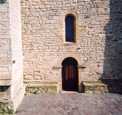 On
the west face about 12 feet from the ground there are some triangular shaped
dressed stones that are reminiscent of late Roman wall facings. There is evidence
of the south-west angle having being rebuilt after a collapse of the tower.
In the south-west angle a circular stone staircase was built. On
the west face about 12 feet from the ground there are some triangular shaped
dressed stones that are reminiscent of late Roman wall facings. There is evidence
of the south-west angle having being rebuilt after a collapse of the tower.
In the south-west angle a circular stone staircase was built.
The tower was built in three stages. The first two were built late 11th or
early 12th Century and the third stage built in the 14th Century. The tower
has clasping and corner buttresses of different sizes some of which are gabled.
The second stage has to the south a restored round-headed window, and the third
stage has four 14th century double lancet bell openings with cusped heads.
During this time the first listed incumbent appeared a certain Ralph c1160.
According to a document in Nottinghamshire Archives, Edmund Collabell of Nettleworth,
gent, was buried in the church. The executors “to lay on the grave an
alabaster stone with a picture of me and Jane my late wife with our names to
be written of the same” 23rd November 1556. Internally, there is a stunning
east arch with dogtooth moulding that looks barbaric.
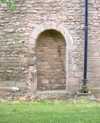 Warsop
at this time was growing in stature, and fifty or so years after the foundation
in the 12th Century saw the addition of the aisles. The blocked doorway in
the north aisle, the blocked window in the north aisle, and the priest’s
doorway in the south wall of the chancel, all belong to this period. Warsop
at this time was growing in stature, and fifty or so years after the foundation
in the 12th Century saw the addition of the aisles. The blocked doorway in
the north aisle, the blocked window in the north aisle, and the priest’s
doorway in the south wall of the chancel, all belong to this period.
At the Early English Period, the north nave arcade of three bays and the south
porch were constructed. The north arcade has octagonal columns and caps, and
the half column forming the west respond in the form of a pointed bow-tell.
The outer door of the porch is a good specimen with two detached columns having
carved caps and square abaci. The mouldings round the arch are ornamented with
nail head and small pointed bow-tell on the inner face.
At the end of the reign of Edward I, in the early 14th Century, further alterations
were embarked upon, principally the south arcade, the inner door of the porch
and the sedilia (at different levels for priest, deacon and sub-deacon) and
the piscina in the chancel (where the spare water was poured after the Eucharist)
were built. The sections of each of the columns of this arcade consist of four
rolls and fillets. The capitals and bases have good mouldings and the columns
stand on circular plinths that were possibly used as seats as there were no
pews in churches at this time. The arch in the chancel has been raised three
feet above the original.
On 22nd September 1563, Henry the Earl of Rutland died . The Earl of Rutland
was lord of the manor of Warsop and patron of the living, and that undoubtedly
is the reason the entry of his death is made here. He was buried at Bottesford
in Leicestershire.
At this time there was an agreement between the inhabitants of Warsop and
Sookholme“that Soukholme (sic) men shall paye to the churchwardens of
Warsoppe the fourth part of all charges to wind and weather, and to the keeping
of the bells in repayre, and to the charges of the visitations.” (1626)
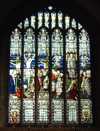 The
clerestory is 15th Century with three windows on each side. The north side
has two lights and the south side, three. The massive six light east window
was also constructed at this time. Also around this time, the plain parapet
was added round the nave, chancel and aisles. In the north side of the chancel,
the church now has an organ chamber that is a modern addition. The population
of Warsop, was according to the Protestation returns of 1676 were around 159
males. The
clerestory is 15th Century with three windows on each side. The north side
has two lights and the south side, three. The massive six light east window
was also constructed at this time. Also around this time, the plain parapet
was added round the nave, chancel and aisles. In the north side of the chancel,
the church now has an organ chamber that is a modern addition. The population
of Warsop, was according to the Protestation returns of 1676 were around 159
males.
Around this time, Warsop church could have had a steeple. According to the
Nottingham Archdeaconry records Christopher Featherstone of Warsop found himself
before the Archdeacons court for “wishing the church steeple down (and
when he had paid his church laye (with a very ill will) for saying the divill
go with it.)” This occurred on the 10th November 1629 and on the 24th
November he “did but wish the church on the other side of the water”.
This case was dismissed.
Around 1775, two-thirds of this parish was enclosed by agreement, and the
rest by an act passed in 1818. However the award was not signed until 1824
when 713a 3r 13p were allocated to the Rector in lieu of all the tithes in
the parish.
According to Archbishop Herring’s visitation returns, the Parish of
Warsop seemed to be in a state of disarray, due to the fact that repairs were
not being done on the Parson’s house and that the number of attendees
and communicants were not being kept accurately. The letter from the Rector
of that time Reverend John Mosely reads thus:
[Warsop, Retford]
May it Please Your Grace 20th Sept. 1743
May Your Grace Please to accept the following Best Answers that I can make
to Your quaestions (sic) proposed 1st that there are about 130 families in
the Parish of Warsop & one family onely Dissenters & they Roman Catholicks
2d there is no meeting house 3d no Charity School 4 there is no Charity except
to bread to Poor people of nine pounds without Trustees Land in the Hands
of Trustees Daniel Newton & others the Interest & rent of which I
believe are duely apllied(sic) to the proper uses 5th I have hitherto resided
in the town of Warsop the Parsonage House is not yet thoroughly repaired
6th I have continued the Curate who Served my Predecessor till he can gett
better provision unless &c 7 I know no Such person 8th Publick Service
is red on holy days twice on Sundays 9th And Children are Catechised four
Sundays or more 10th Sacrament is administered 8 times in the year but I
do not know how many Communicants there are or how many reciev’d last
time 11th Open & timely notice as required is given but the Parishoners
don’t give in their names & none have been refused
I am Your Grace his Obliged & Obiedient Humble Servant
JOHN MOSLEY Rector of Warsop Nottishr.
Methodism appeared in Warsop around 1815 and the services were held in the
now Scrooges Discount Store shop. Later a chapel was built further up Sherwood
Street the remains of which can be seen behind number 74, and still later the
chapel in Burns Lane which is now Earl Engineering. The origin of the Clumber
Street, however, was in a meeting at a house on Dorney Hill on 22nd December
1850. The house on Dorney Hill is now demolished. The founders of the new Society
included Mr Thomas Wilson and Mrs T Hallifax. A chapel was built
in 1858, by Mr W Taylor, at the corner of Sherwood Street and Clumber
Street. In 1857, the society joined the United Methodist Free Church. By 1900,
the society had outgrown the old chapel, and memorial stones of the present
church were laid on the 11th June 1902. Five years later the United Methodist
Free Church was absorbed in the United Methodist Church, and in 1932 in the
Methodist Church as we know it now. The Methodist Church also have a chapel
in Welbeck Colliery Village (now known as Meden Vale). The founding stone was
laid on 1st October, 1927, and was opened on the 29th February 1928.
Warsop did not escape the restoration of the churchwardens of the seventeenth
century who inserted two debased square headed windows in the south aisle;
these disappeared at the restoration of 1877. In 1844, a clock was installed
in Warsop church tower, with two faces to the south and east. During the 18th
Century, a window existed of three lancet arches under one hood mould in the
south wall of the chancel near the east of the south aisle now replaced by
one in the Decorated style. 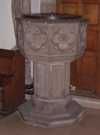 According
to Glynne, 13th December 1851, “there is a fine new font of octagonal
form”. In the 19th Century, there were two attempts to restore the deteriorating
parish church. The first was in 1872 and a brief mention of this was made in
the Parish magazine: According
to Glynne, 13th December 1851, “there is a fine new font of octagonal
form”. In the 19th Century, there were two attempts to restore the deteriorating
parish church. The first was in 1872 and a brief mention of this was made in
the Parish magazine:
Among other changes made during 1872, we note the removal
of the gallery in the church, the removal of the organ to its proper place,
namely the chancel, the substitution of Hymns Ancient and Modern for Mercers
Hymn Book, the choir being surpliced and above all the weekly celebration of
Holy Communion.
At some point, in the 19th Century, a pulpit, traceried and fitted with marble
shafts was installed. This looks like the influence of an Oxford Movement priest,
possibly the FitzHerberts.
In 1877, the church was restored at a cost of three thousand pounds. During
the remodelling of the interior and the replacement of the high backed pews
part of the roof fell in. On further investigation, it was discovered that
the timbers were rotten and the nave pillar was cracked and crumbling at the
base. The windows in the rector’s were taken from the east window and
is the oldest stained glass in the church dating back to the 13th or 14th Century.
There is a head of a female saint with yellow hair and a portion of a nimbus
with side locks from another figure. There are two other bearded heads, one
with a brimmed hat similar to the description in Canterbury Tales where there
is a description of one who wore a Flandrith Beaver Hat with the Lexington
Arms argent across paty azure which translated means “the field of white
glass beautifully diapered”. Unfortunately, due to a recent break-in,
the beauty of these windows has been greatly reduced, with them being patched
up with plain glass.
 In
1913 an oak reredos in the style of the 15th century was installed, and in
1930 a Baroque style oak screen which is known as the Beard Screen. The screen
is inscribed: In
1913 an oak reredos in the style of the 15th century was installed, and in
1930 a Baroque style oak screen which is known as the Beard Screen. The screen
is inscribed:
AMDG This Screen was erected in memory of Joseph Beard,
Churchwarden of this parish 1885-1930 and of his sister Elizabeth Beard.
The most important event of the last century was a request by the Staveley
Coal and Iron Company to mine under the church. The request was agreed to on
the condition that any damage done was repaired at the company’s expense.
In the 1930's mining commenced but the movement of the church was so alarming
that it was found necessary to prop the church up externally and internally.
The foundations of the church were placed on girders to form a bed and the
stained glass in the east window was put into storage.
During the Second World War there were two minor additions to the church.
These were the two carved angels at the entrance of the chancel. One is a thank
offering for the safe return of two sons from the war and the other is in memory
of C G Polkey who was killed in action in France 1944.
Pentecostalism appeared in 1948. In the village of Church Warsop there is
a small church that belongs to the Bethel Full Gospel Church. This congregation
originally met in a small wooden hut, but in 1948 they moved next door into
the disused Salvation Army building. The Salvation Army had used the building
since 1936. The first minister was Joseph Tonks.
Roman Catholicism appeared in 1956. They too started off with a wooden hut,
which was replaced later by a permanent brick building on the same site. The
wooden hut lasted from 1956-1973. When the brick church was constructed they
became the sister church to St Joseph’s at Shirebrook. Fr Joseph
McGovern celebrated the first mass in 1974.
The restoration of the church in 1957 cost £22,000 and was paid for
by the then National Coal Board (£18,000) and public support. Adam Eastwood
and Sons were the contractors, a local building firm.
After the completion of the restoration in 1957, the tomb of the Rt Rev
Samuel Hallifax was found under the chancel. Samuel Hallifax was once the Bishop
of Gloucester and St Asaph. Photographs were taken and the coffin plate
was placed on the south chancel wall.
A major alteration to the interior appearance of the church was effected in
the early 1970s when the choir stalls were removed (now incorporated in the
gallery of the Tudor Barn in the Parish Centre) to allow repositioning of the
high altar nearer to the people. The east end of the chancel now serves as
a chapel for daily services. Also during the 1970s the kerbstones were removed
and the gravestones were transferred to the periphery to allow for easier grasscutting.
At the same time a Garden of Remembrance was established for the internment
of cremated remains in the north west corner of the churchyard.
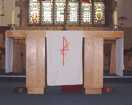 In
1990, due to the fact that the old altar was considered a security risk, a
new one was commissioned. This was manufactured by William Wright and consecrated
by the Rt Rev Alan Morgan, Bishop of Sherwood. The old altar was transferred
with all its furnishings to St Mark’s, Mansfield. In
1990, due to the fact that the old altar was considered a security risk, a
new one was commissioned. This was manufactured by William Wright and consecrated
by the Rt Rev Alan Morgan, Bishop of Sherwood. The old altar was transferred
with all its furnishings to St Mark’s, Mansfield.
 Another
addition to the church was the installation of the Millennium Window. This
was begun under the incumbency of the Rev Clifford Bowman, and after much consultation,
the design of the Madonna and Child was chosen. This was designed by Sallie
Wood and was installed in 2002. The Bishop of Southwell, the Rt Rev George
Cassidy dedicated this window on the 21st April 2002 during the Family Communion
Service. This window was manufactured by Mick Stokes. Another
addition to the church was the installation of the Millennium Window. This
was begun under the incumbency of the Rev Clifford Bowman, and after much consultation,
the design of the Madonna and Child was chosen. This was designed by Sallie
Wood and was installed in 2002. The Bishop of Southwell, the Rt Rev George
Cassidy dedicated this window on the 21st April 2002 during the Family Communion
Service. This window was manufactured by Mick Stokes.
Warsop today is comprised mainly of small shops (sadly many of them boarded
up) and business units, and there are four schools in the town with another
two at Meden Vale and Church Warsop respectively. The school at Warsop Vale
was turned into a factory, and the infant and junior schools were combined
into one purpose built school known as Church Vale school. The area has suffered
badly in the past years due to the pit closure programme. However, there is
a potentially a brighter future for the area.
Until 1971, the social activities of the church were focussed on the Mission
Hall in Warsop. When these premises had to be relinquished, several alternatives
were considered. Finally, however, the offer to use the Old Hall Farm buildings
by the FitzHerbert family was accepted. Old Hall Farm stands just outside the
north west corner of the churchyard and has been described as a very interesting
example of a small 14th Century Nottinghamshire Hall. The hall was connected
to the church by a small doorway that still exists in the churchyard wall,
and there were also tunnels, which connected the hall to the church and the
former rectory. These were blocked because of flooding. It was in this building
that Lady Gally Knight the last of the Gally Knights lived and died.
The following article written by Jeffrey Noble before the restoration was
completed states:
Although Warsop has recently seen the loss of the 17th Century rectory,
the medieval dovecote, the old packhorse bridge and a number of ancient farms
and cottages at least the trend has been reversed in one case.
The Old Hall Farm next to the church, regarded as probably the most important
medieval house in the county was in use as a mere poultry house until over
a year ago. Then the lease on the parish mission hall terminated, and a scheme
was proposed to construct a new parish centre near the church. With ever
mounting costs the more the parish attempted to raise money the further off
the target they seemed to be. Then somebody said “Why not use the Old
Hall Farm?”
The idea was accepted, the FitzHerbert family agreed to sell and from then
on with contributions from church people, the people of Warsop and additional
contributions of the now disbanded Warsop Urban District Council, and the
Nottinghamshire Buildings Preservation Trust it was possible to enact a thorough
conversion to the fine building that can be seen today.
Another recent conversion is that of the Stable Barn, which was a run down
hut that was used as a meeting place for the Adventurers in the past and was
later used as a store for the youth groups of the church. This was converted
for the use of the Centre Club, and was opened by the Rev David Leaning in
1997.
Upstairs in the Parish Centre there is the church office where all bookings
for baptisms and weddings take place and there are several large rooms available
for hire. Little is known of the history of the building itself. It has for
many years been a farmhouse, but it is without doubt the ancient Manor of Warsop.
Its thick walls contain many recesses similar to those found in many ancient
churches and this points to some form of ecclesiastical use. However, just
before the Dissolution of the Monasteries, the monks of Welbeck were renting
nearby pastures. A fine medieval beam with a series of designs in relief and
a grotesque face at each end has been incorporated into the main ground floor
room. It was rescued from the old rectory that was demolished to make way for
the widening of the A60
Church Registers
The oldest contains the baptisms from 1539 to 1637 at one end and the burials
and marriages from 1538-1637 at the other. There are no baptisms recorded in
1555, no burials from 1543 to 1637 inclusive and no marriages from 1543 to
1578 inclusive. The next one contains the baptisms, burials, and weddings from
1638 to 1742. No entry of any kind was made for the year 1645. There are two
volumes known as register C, the first containing the baptisms from 1743 to
1812 at one end, burials from the same period and marriages from 1743 to 1776
at the other.
Volume II contains the marriages with banns from 1754 to 1812. There is a
register D that consists of three paper volumes containing the baptisms burials
and marriages up to 1907. There are wedding, banns of marriage, confirmation,
service, and burial registers for the latter half of the 20th Century kept
in the main safe.
Relevant dates
1086A church is mentioned in Domesday
1160Earliest named rector
1877Restored church opened by
Bishop of Hereford
1957Further restoration of the
church following mining work by Adam Eastwood
1971Formation of Parish Centre
from old farm buildings
2002Installation of Millennium
Window
| 




